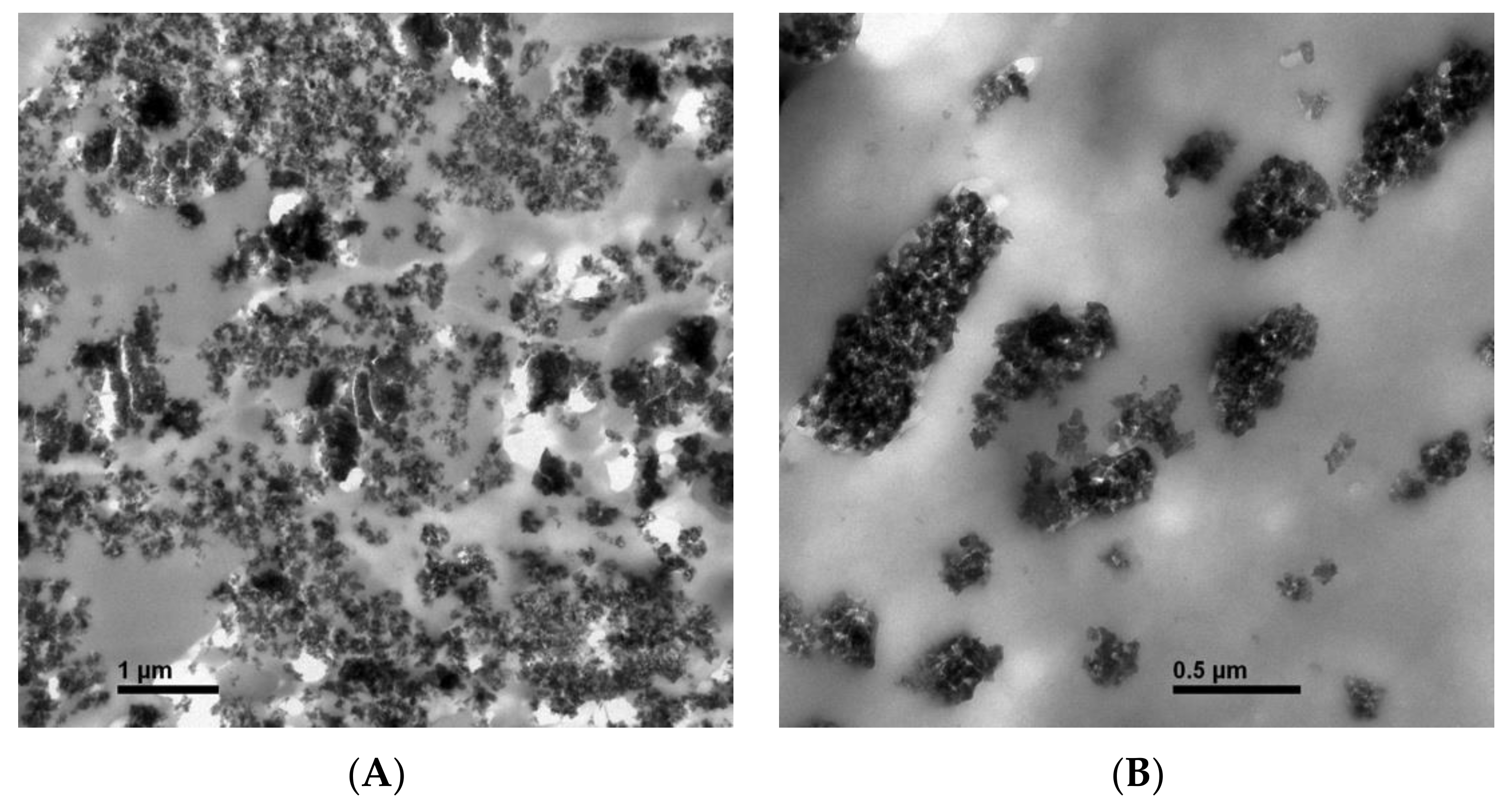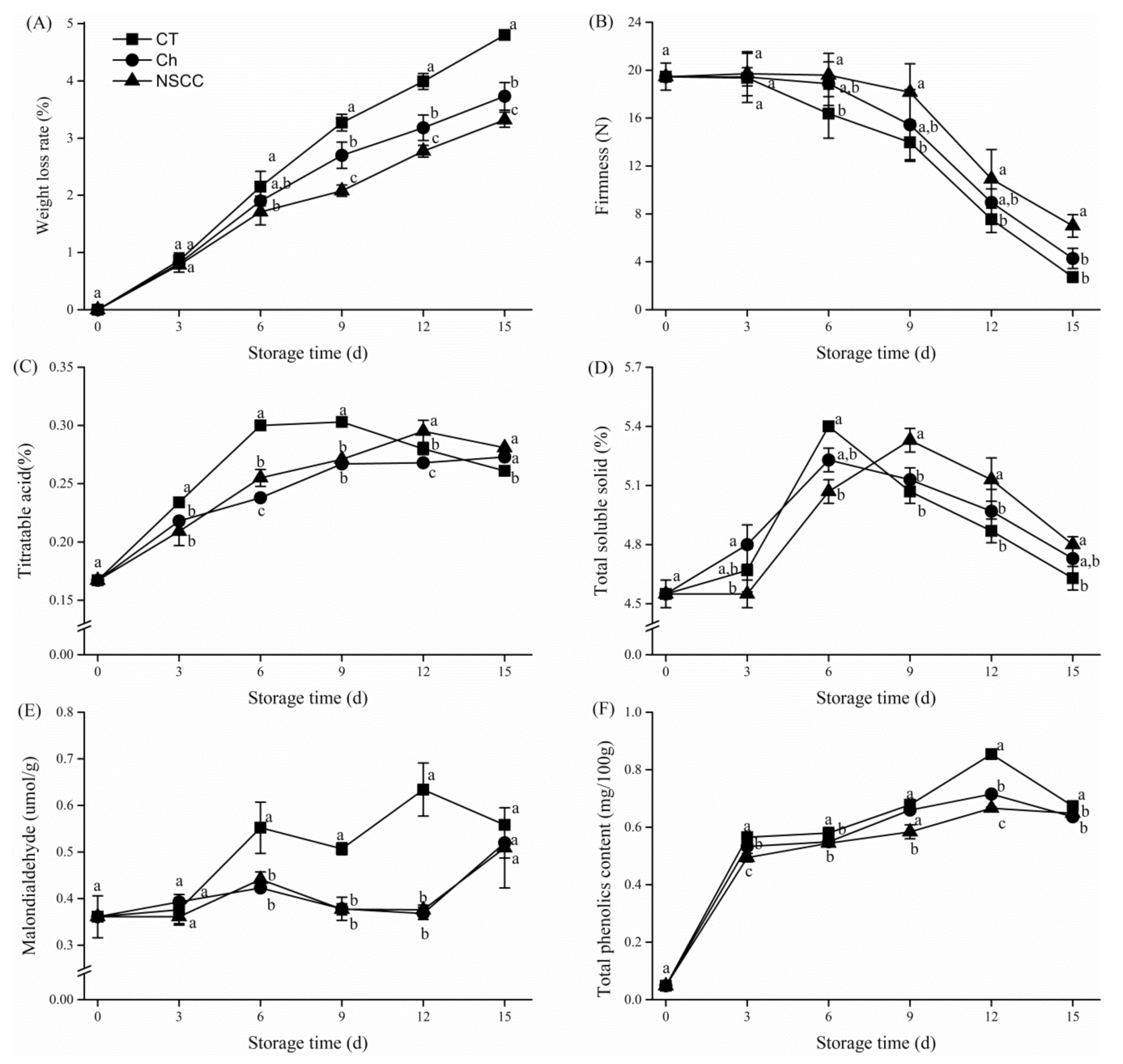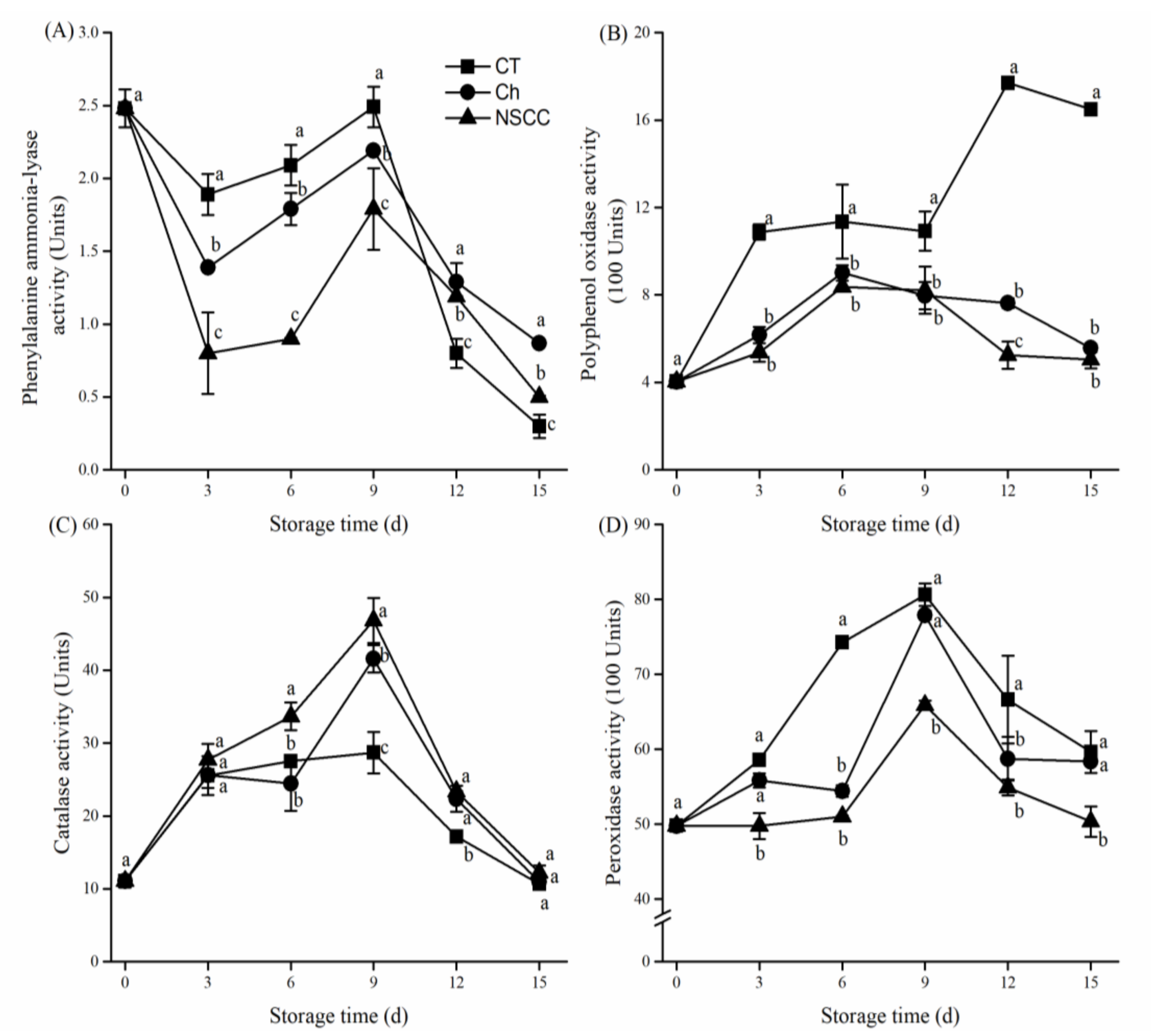Effect of Nano-SiOx/Chitosan Complex Coating on the Physicochemical Characteristics and Preservation Performance of Green Tomato
Abstract
1. Introduction
2. Results
2.1. Physical Properties and Microstructure
2.2. Antimicrobial Activity
2.3. Weight Loss Rate, Firmness, Titratable Acid, Total Soluble Solid, Malondialdehyde, and Total Phenolics Content
2.4. Antioxidant Enzymes
3. Discussion
4. Materials and Methods
4.1. Preparation of Chitosan (Ch) and Nano-SiOx/Chitosan Complex (NSCC) Films
4.2. Evaluation of the Microstructures and Physical Properties of Ch and NSCC Films
4.2.1. Water Vapor Transmission Rate (P)
4.2.2. O2 Transmission Coefficient
4.2.3. CO2 Transmission Coefficient
4.2.4. Measurement of Light Transmittance
4.2.5. Tensile Strength
4.2.6. Transmission Electron Microscopy
4.3. Antimicrobial Activity
4.3.1. Bacterial Strains
4.3.2. Preparation of Bacterial Culture
4.3.3. Determination of Inhibition Zone
4.4. Plant Material and Sampling
4.5. Weight Loss Rate, Firmness, Titratable Acid, Total Soluble Solid, Malondialdehyde, and Total Phenolics Content
4.6. Phenylalanine Ammonia-Lyase (PAL), Polyphenol Oxidase (PPO), Catalase (CAT), and Peroxidase (POD) Activity
4.7. Statistical Analysis
5. Conclusions
Supplementary Materials
Author Contributions
Funding
Conflicts of Interest
References
- Chaturvedi, K.; Sharma, N.; Yadav, S.K. Composite edible coatings from commercial pectin, corn flour and beetroot powder minimize post-harvest decay, reduces ripening and improves sensory liking of tomatoes. Int. J. Biol. Macromol. 2019, 133, 284–293. [Google Scholar]
- Wu, S.; Huang, J.; Wu, Q.; Zhang, F.; Zhang, J.; Lei, T.; Chen, M.; Ding, Y.; Xue, L. Prevalence and Characterization of Staphylococcus aureus Isolated From Retail Vegetables in China. Front. Microbiol. 2018, 9, 1263. [Google Scholar] [CrossRef] [PubMed]
- Cuvi, M.J.A.; Vicente, A.R.; Concellón, A.; Chaves, A.R. Changes in red pepper antioxidants as affected by UV-C treatments and storage at chilling temperatures. LWT Food Sci. Technol. 2011, 44, 1666–1671. [Google Scholar] [CrossRef]
- Shewfelt, R.L.; Erickson, M.C. Role of lipid peroxidation in the mechanism of membrane-associated disorders in edible plant tissue. Trends Food Sci. Technol. 1991, 2, 152–154. [Google Scholar] [CrossRef]
- Balasundram, N.; Sundram, K.; Samman, S. Phenolic compounds in plants and agri-industrial by-products: Antioxidant activity, occurrence, and potential uses. Food Chem. 2006, 99, 191–203. [Google Scholar] [CrossRef]
- Nawab, A.; Alam, F.; Hasnain, A. Mango kernel starch as a novel edible coating for enhancing shelf- life of tomato (Solanum lycopersicum) fruit. Int. J. Biol. Macromol. 2017, 103, 581–586. [Google Scholar] [CrossRef]
- Divya, K.; Vijayan, S.; Jisha, M.S. Antifungal, antioxidant and cytotoxic activities of chitosan nanoparticles and its use as an edible coating on vegetables. Int. J. Biol. Macromol. 2018, 114. [Google Scholar] [CrossRef]
- Perdones, Á.; Tur, N.; Chiralt, A.; Vargas, M. Effect on tomato plant and fruit of the application of biopolymer-oregano essential oil coatings. J. Sci. Food Agric. 2016, 96, 4505–4513. [Google Scholar] [CrossRef]
- Mustafa, M.A.; Ali, A.; Manickam, S.; Siddiqui, Y. Ultrasound-Assisted Chitosan–Surfactant Nanostructure Assemblies: Towards Maintaining Postharvest Quality of Tomatoes. Food Bioprocess Technol. 2014, 7, 2102–2111. [Google Scholar] [CrossRef]
- Alicja, S.; MaGorzata, G.; Karolina, K.N.; Anna, C.M.; Przyby, J.A.L.; Katarzyna, B.C.; Zenon, W.G. Effect of meadowsweet flower extract-pullulan coatings on rhizopus rot development and postharvest quality of cold-stored red peppers. Molecules 2014, 19, 12925–12939. [Google Scholar]
- Gooneh-Farahani, S.; Naimi-Jamal, M.R.; Naghib, S.M. Stimuli-responsive graphene-incorporated multifunctional chitosan for drug delivery applications: A review. Expert Opin. Drug Deliv. 2019, 16, 79–99. [Google Scholar] [CrossRef] [PubMed]
- Arnon-Rips, H.; Porat, R.; Poverenov, E. Enhancement of agricultural produce quality and storability using citral-based edible coatings; The valuable effect of nano-emulsification in a solid-state delivery on fresh-cut melons model. Food Chem. 2019, 277, 205–212. [Google Scholar] [CrossRef] [PubMed]
- Tang, Y.; Hu, X.; Zhang, X.; Guo, D.; Zhang, J.; Kong, F. Chitosan/titanium dioxide nanocomposite coatings: Rheological behavior and surface application to cellulosic paper. Carbohydr. Polym. 2016, 151, 752–759. [Google Scholar] [CrossRef] [PubMed]
- Lin, B.; Luo, Y.; Zi, T.; Zhang, B.; Zhou, B.; Qin, W. Development of silver/titanium dioxide/chitosan adipate nanocomposite as an antibacterial coating for fruit storage. LWT Food Sci. Technol. 2015, 63, 1206–1213. [Google Scholar] [CrossRef]
- Kour, H.; Wani, N.A.T.; Malik, A.; Kaul, R.; Chauhan, H.; Gupta, P.; Bhat, A.; Singh, J. Advances in food packaging–A review. Stewart Postharvest Rev. 2013, 9, 1–7. [Google Scholar]
- Shi, S.; Wei, W.; Liu, L.; Wu, S.; Wei, Y.; Li, W. Effect of chitosan/nano-silica coating on the physicochemical characteristics of longan fruit under ambient temperature. J. Food Eng. 2013, 118, 125–131. [Google Scholar] [CrossRef]
- Sun, T.; Wu, C.L.; Hao, H.; Dai, Y.; Li, J.R. Preparation and preservation properties of the chitosan coatings modified with the in situ synthesized nano SiOx. Food Hydrocoll. 2016, 54, 130–138. [Google Scholar] [CrossRef]
- Fadeyibi, A.; Osunde, Z.D.; Egwim, E.C.; Idah, P.A. Performance evaluation of cassava starch-zinc nanocomposite film for tomatoes packaging. J. Agric. Eng. 2017, 48, 137–146. [Google Scholar] [CrossRef]
- Kaewklin, P.; Siripatrawan, U.; Suwanagul, A.; Lee, Y.S. Active packaging from chitosan-titanium dioxide nanocomposite film for prolonging storage life of tomato fruit. Int. J. Biol. Macromol. 2018, 112, 523–529. [Google Scholar] [CrossRef]
- Juan, Z.; Shaoying, Z.; Youwei, Y.; Yinzhe, R. Cherry tomato preservation using chitosan combined with zinc/cerium ion. Int. J. Nutr. Food Sci. 2014, 3, 111–118. [Google Scholar] [CrossRef]
- Duan, J.L.; Zhang, S.Y. Application of chitosan based coating in fruit and vegetable preservation: A review. Food Process. Technol. 2013, 4, 227. [Google Scholar] [CrossRef]
- Park, J.H.; Park, D.S.; Hahn, B.D.; Choi, J.J.; Ryu, J.; Choi, S.Y.; Kim, J.; Yoon, W.H.; Chan, P. Effect of raw powder particle size on microstructure and light transmittance of α-alumina films deposited by granule spray in vacuum. Ceram. Int. 2016, 42, 3584–3590. [Google Scholar] [CrossRef]
- Oms-Oliu, G.; Soliva-Fortuny, R.; Martín-Belloso, O. Using polysaccharide-based edible coatings to enhance quality and antioxidant properties of fresh-cut melon. LWT Food Sci. Technol. 2008, 41, 1862–1870. [Google Scholar] [CrossRef]
- Ghidelli, C.; Pérez-Gago, M.B. Recent advances in modified atmosphere packaging and edible coatings to maintain quality of fresh-cut fruits and vegetables. Crit. Rev. Food Sci. Nutr. 2016, 58, 662–679. [Google Scholar] [CrossRef]
- Anchis, E.; Ghidelli, C.; Palou, L.; Perezgago, M.B.; Gonzalez, S.; Sheth, C.; Mateos, M. Browning inhibition and microbial control in fresh-cut persimmon (diospyros kaki ‘Rojo Brillante’) by apple pectin-based edible coatings. Postharvest Biol. Technol. 2016, 112, 186–193. [Google Scholar] [CrossRef]
- Zemljič, L.F.; Tkavc, T.; Vesel, A.; Šauperl, O. Chitosan coatings onto polyethylene terephthalate for the development of potential active packaging material. Appl. Surf. Sci. 2013, 265, 697–703. [Google Scholar] [CrossRef]
- Arkoun, M.; Daigle, F.; Heuzey, M.C.; Ajji, A. Mechanism of Action of Electrospun Chitosan-Based Nanofibers against Meat Spoilage and Pathogenic Bacteria. Molecules 2017, 22, 585. [Google Scholar] [CrossRef]
- Zhang, X.; Xiao, G.; Wang, Y.; Zhao, Y.; Su, H.; Tan, T. Preparation of Chitosan-TiO2 Composite Film with Efficient Antimicrobial Activities under Visible Light for Food Packaging Applications. Carbohydr. Polym. 2017, 169, 101. [Google Scholar] [CrossRef]
- Zhang, Z.; Liu, L.; Zhang, M.; Zhang, Y.; Wang, Q. Effect of carbon dioxide enrichment on health-promoting compounds and organoleptic properties of tomato fruits grown in greenhouse. Food Chem. 2014, 153, 157–163. [Google Scholar] [CrossRef]
- Nkolisa, N.; Magwaza, L.S.; Workneh, T.S.; Chimpango, A. Evaluating evaporative cooling system as an energy-free and cost-effective method for postharvest storage of tomatoes (Solanum lycopersicum L.) for smallholder farmers. Sci. Hortic. 2018, 241, 131–143. [Google Scholar] [CrossRef]
- Zahedi, S.M.; Hosseini, M.S.; Karimi, M.; Ebrahimzadeh, A. Effects of postharvest polyamine application and edible coating on maintaining quality of mango (Mangifera indica L.) cv. Langra during cold storage. Food Sci. Nutr. 2019, 7, 433–441. [Google Scholar] [CrossRef] [PubMed]
- Li, Y.-N.; Ye, Q.-Q.; Hou, W.-F.; Zhang, G.-Q. Development of antibacterial ε-polylysine/chitosan hybrid films and the effect on citrus. Int. J. Biol. Macromol. 2018, 118, 2051–2056. [Google Scholar] [CrossRef] [PubMed]
- Raghav, P.K.; Agarwal, N.; Saini, M. Edible coating of fruits and vegetables: A review. Int. J. Sci. Res. Mod. Educ. 2016, I, 188–204. [Google Scholar]
- Zheng, Y.; Sheng, J.; Zhao, R.; Zhang, J.; Lv, S.; Liu, L.; Shen, L. Preharvest L-arginine treatment induced postharvest disease resistance to Botrysis cinerea in tomato fruits. J. Agric. Food Chem. 2011, 59, 6543–6549. [Google Scholar] [CrossRef] [PubMed]
- Liplap, P.; Charlebois, D.; Charles, M.T.; Toivonen, P.; Vigneault, C.; Raghavan, G.V. Tomato shelf-life extension at room temperature by hyperbaric pressure treatment. Postharvest Biol. Technol. 2013, 86, 45–52. [Google Scholar] [CrossRef]
- Jagadeesh, S.; Charles, M.; Gariepy, Y.; Goyette, B.; Raghavan, G.; Vigneault, C. Influence of postharvest UV-C hormesis on the bioactive components of tomato during post-treatment handling. Food Bioprocess Technol. 2011, 4, 1463–1472. [Google Scholar] [CrossRef]
- Liu, C.; Han, X.; Cai, L.; Lu, X.; Ying, T.; Jiang, Z. Postharvest UV-B irradiation maintains sensory qualities and enhances antioxidant capacity in tomato fruit during storage. Postharvest Biol. Technol. 2011, 59, 232–237. [Google Scholar] [CrossRef]
- Li, R.; Liu, C.; Zhao, R.; Wang, L.; Chen, L.; Yu, W.; Zhang, S.; Sheng, J.; Shen, L. CRISPR/Cas9-Mediated SlNPR1 mutagenesis reduces tomato plant drought tolerance. BMC Plant Biol. 2019, 19, 38. [Google Scholar] [CrossRef]
- Gerganova, M.; Popova, A.V.; Stanoeva, D.; Velitchkova, M. Tomato plants acclimate better to elevated temperature and high light than to treatment with each factor separately. Plant Physiol. Biochem. 2016, 104, 234–241. [Google Scholar] [CrossRef]
- Moles, T.M.; Mariotti, L.; De Pedro, L.F.; Guglielminetti, L.; Picciarelli, P.; Scartazza, A. Drought induced changes of leaf-to-root relationships in two tomato genotypes. Plant Physiol. Biochem. 2018, 128, 24–31. [Google Scholar] [CrossRef]
- Gürsul, I.; Gueven, A.; Grohmann, A.; Knorr, D. Pulsed electric fields on phenylalanine ammonia lyase activity of tomato cell culture. J. Food Eng. 2016, 188, 66–76. [Google Scholar] [CrossRef]
- Castagna, A.; Dall’Asta, C.; Chiavaro, E.; Galaverna, G.; Ranieri, A. Effect of post-harvest UV-B irradiation on polyphenol profile and antioxidant activity in flesh and peel of tomato fruits. Food Bioprocess Technol. 2014, 7, 2241–2250. [Google Scholar] [CrossRef]
- Richard-Forget, F.C.; Gauillard, F.A. Oxidation of chlorogenic acid, catechins, and 4-methylcatechol in model solutions by combinations of pear (Pyrus communis cv. Williams) polyphenol oxidase and peroxidase: A possible involvement of peroxidase in enzymatic browning. J. Agric. Food Chem. 1997, 45, 2472–2476. [Google Scholar] [CrossRef]
- Deuchande, T.; Larrigaudière, C.; Giné-Bordonaba, J.; Carvalho, S.M.; Vasconcelos, M.W. Biochemical basis of CO2-related internal browning disorders in pears (Pyrus communis L. cv. Rocha) during long-term storage. J. Agric. Food Chem. 2016, 64, 4336–4345. [Google Scholar] [CrossRef] [PubMed]
- Xu, J.; Duan, X.; Yang, J.; Beeching, J.R.; Zhang, P. Enhanced reactive oxygen species scavenging by overproduction of superoxide dismutase and catalase delays postharvest physiological deterioration of cassava storage roots. Plant Physiol. 2013, 161, 1517–1528. [Google Scholar] [CrossRef] [PubMed]
- Dermesonlouoglou, E.; Giannakourou, M.; Taoukis, P. Kinetic modelling of the degradation of quality of osmo-dehydrofrozen tomatoes during storage. Food Chem. 2007, 103, 985–993. [Google Scholar] [CrossRef]
- Li, H.; Li, F.; Wang, L.; Sheng, J.; Xin, Z.; Zhao, L.; Xiao, H.; Zheng, Y.; Hu, Q. Effect of nano-packing on preservation quality of Chinese jujube (Ziziphus jujuba Mill. var. inermis (Bunge) Rehd). Food Chem. 2009, 114, 547–552. [Google Scholar] [CrossRef]
- Singh, T.P.; Chauhan, G.; Agrawal, R.K.; Mendiratta, S.K. Response surface modeling and optimization of tomato puree–casein bio-composite films. Iran. Polym. J. 2018, 27, 861–879. [Google Scholar] [CrossRef]
- Zhang, R.; Wang, X.; Li, L.; Cheng, M.; Zhang, L. Optimization of konjac glucomannan/carrageenan/nano-SiO2 coatings for extending the shelf-life of Agaricus bisporus. Int. J. Biol. Macromol. 2019, 122, 857–865. [Google Scholar] [CrossRef]
- Lozanonavarro, J.; Díazzavala, N.; Velascosantos, C.; Martínezhernández, A.; Tijerinaramos, B.; Garcíahernández, M.; Riveraarmenta, J.; Páramogarcía, U.; Torre, A.R.L. Antimicrobial, Optical and Mechanical Properties of Chitosan–Starch Films with Natural Extracts. Int. J. Mol. Sci. 2017, 18, 1–18. [Google Scholar]
- Kaya, M.; Ravikumar, P.; Ilk, S.; Mujtaba, M.; Akyuz, L.; Labidi, J.; Salaberria, A.M.; Cakmak, Y.S.; Erkul, S.K. Production and characterization of chitosan based edible films from Berberis crataegina’s fruit extract and seed oil. Innov. Food Sci. Emerg. Technol. 2018, 45, 287–297. [Google Scholar] [CrossRef]
- Luo, Z. Extending shelf-life of persimmon (Diospyros kaki L.) fruit by hot air treatment. Eur. Food Res. Technol. 2006, 222, 149–154. [Google Scholar] [CrossRef]
- Liu, Z.; Li, L.; Luo, Z.; Zeng, F.; Jiang, L.; Tang, K. Effect of brassinolide on energy status and proline metabolism in postharvest bamboo shoot during chilling stress. Postharvest Biol. Technol. 2016, 111, 240–246. [Google Scholar] [CrossRef]
- Feng, S.; Luo, Z.; Tao, B.; Chen, C. Ultrasonic-assisted extraction and purification of phenolic compounds from sugarcane (Saccharum officinarum L.) rinds. LWT Food Sci. Technol. 2015, 60, 970–976. [Google Scholar] [CrossRef]
- Cheng, G.W.; Breen, P.J. Activity of phenylalanine ammonia-lyase (PAL) and concentrations of anthocyanins and phenolics in developing strawberry fruit. J. Am. Soc. Hortic. Sci. 1991, 116, 865–869. [Google Scholar] [CrossRef]
- Luo, Z.; Xu, X.; Yan, B. Accumulation of lignin and involvement of enzymes in bamboo shoot during storage. Eur. Food Res. Technol. 2008, 226, 635–640. [Google Scholar] [CrossRef]
- Jiang, Y.-M. Purification and some properties of polyphenol oxidase of longan fruit. Food Chem. 1999, 66, 75–79. [Google Scholar] [CrossRef]
- Luo, Z.; Li, D.; Du, R.; Mou, W. Hydrogen sulfide alleviates chilling injury of banana fruit by enhanced antioxidant system and proline content. Sci. Hortic. 2015, 183, 144–151. [Google Scholar] [CrossRef]
- Luo, Z.; Feng, S.; Pang, J.; Mao, L.; Shou, H.; Xie, J. Effect of heat treatment on lignification of postharvest bamboo shoots (Phyllostachys praecox f. prevernalis). Food Chem. 2012, 135, 2182–2187. [Google Scholar] [CrossRef]




| Physical Properties | Water Vapor Transmission Rate (kg/m2 d) | O2 Transmission Coefficient (g/d) | CO2 Transmission Coefficient (g/d) | Light Transmittance (%) | Tensile Strength (MPa) |
|---|---|---|---|---|---|
| Ch film | 0.85 ± 0.01 a | 0.0015 ± 0.0002 a | 3.0769 ± 0.0015 b | 66.03 ± 2.93 a | 85.17 ± 1.39 b |
| NSCC film | 0.83 ± 0.00 a | 0.0010 ± 0.0001 b | 3.0905 ± 0.0021 a | 30.65 ± 4.60 b | 124.87 ± 6.28 a |
| Bacterial Strains | Inhibition Zone Diameter (mm) | Inhibition Rate (%) | |||
|---|---|---|---|---|---|
| Acetic Acid Solution (Control) | Ch Solution | NSCC Solution | Ch Solution | NSCC Solution | |
| Escherichia coli | 6.58 ± 0.02 c | 9.40 ± 0.04 b | 11.52 ± 0.09 a | 30.00 ± 0.09 b | 42.88 ± 0.27 a |
| Staphylococcus aureus | 7.80 ± 0.01 c | 9.68 ± 0.03 b | 12.55 ± 0.12 a | 19.45 ± 0.21 b | 37.85 ± 0.51 a |
© 2019 by the authors. Licensee MDPI, Basel, Switzerland. This article is an open access article distributed under the terms and conditions of the Creative Commons Attribution (CC BY) license (http://creativecommons.org/licenses/by/4.0/).
Share and Cite
Zhu, Y.; Li, D.; Belwal, T.; Li, L.; Chen, H.; Xu, T.; Luo, Z. Effect of Nano-SiOx/Chitosan Complex Coating on the Physicochemical Characteristics and Preservation Performance of Green Tomato. Molecules 2019, 24, 4552. https://doi.org/10.3390/molecules24244552
Zhu Y, Li D, Belwal T, Li L, Chen H, Xu T, Luo Z. Effect of Nano-SiOx/Chitosan Complex Coating on the Physicochemical Characteristics and Preservation Performance of Green Tomato. Molecules. 2019; 24(24):4552. https://doi.org/10.3390/molecules24244552
Chicago/Turabian StyleZhu, Yingjie, Dong Li, Tarun Belwal, Li Li, Hangjun Chen, Tingqiao Xu, and Zisheng Luo. 2019. "Effect of Nano-SiOx/Chitosan Complex Coating on the Physicochemical Characteristics and Preservation Performance of Green Tomato" Molecules 24, no. 24: 4552. https://doi.org/10.3390/molecules24244552
APA StyleZhu, Y., Li, D., Belwal, T., Li, L., Chen, H., Xu, T., & Luo, Z. (2019). Effect of Nano-SiOx/Chitosan Complex Coating on the Physicochemical Characteristics and Preservation Performance of Green Tomato. Molecules, 24(24), 4552. https://doi.org/10.3390/molecules24244552










